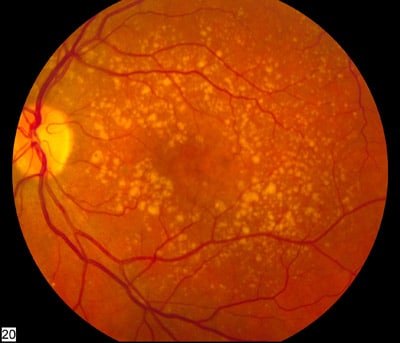
Macular degeneration is one of the leading causes of vision loss amongst aging populations. This condition, which is caused by the deterioration of the macula, makes it so that fine details become difficult to see. There are two kinds of macular degeneration, wet and dry; most cases of macular degeneration start with dry and then one in ten cases end up progressing to wet. Here is a comprehensive overview of macular degeneration, what it is, and what to look out for if you have concerns that it is affecting your vision.
The macula is a very small area near the centre of the retina (light-sensitive tissue where nerves impulses are triggered and pass information through the optic nerve into the brain). The macula is oval in shape and yellow in colour and is the part of the eye that allows us to see images with sharpness. For instance, it is essential for reading and driving. When the macula is damaged or begins to deteriorate daily tasks can become difficult, and it may even become difficult to recognize faces due to the inability to see things sharply. The main field of vision that macular degeneration effects are the central field of vision, where blind spots can occur.
Dry macular degeneration is more common than wet macular degeneration. Around 85% – 95% of patients with the disease having the dry version. Dry macular degeneration is considered non-neovascular. It is often the result of aging when the macular tissue thins and pigment are deposited into the macula. Yellowish spots, called drusen, appearing around the macula is how dry macular degeneration is diagnosed. These spots are deposits from the debris of the deteriorating tissue. The best way to stave off dry macular degeneration is to eat right, exercise, and wear sunglasses to protect your eyes from UV and HEV rays.
Wet macular degeneration is rarer than dry macular degeneration, and is the progression of that disease. Wet macular degeneration is when new blood vessels grow underneath the retina. These blood vessels then leak which permanently damages the light-sensitive retinal cells. As these cells are damaged and die off blind spots are created. There are two distinct types of wet macular degeneration: occult and classic. Occult is not as severe, and leakage is less evident. Classic is the more severe of the two and is the type of wet macular degeneration that results in significant vision loss.
A vast majority of the time age-related macular degeneration is a slow process. It takes time, and you will slowly begin to see spots grow in your vision. On rare occasions though, it can be sudden. There are vision tests that can test to see if you have the disease, such as the Amsler grid, but most cases of macular degeneration are caught before symptoms occur by an optometrist with a retinal exam.
Macular degeneration is found predominately in white and female populations, though risk factors include age, heredity, obesity, inactivity, high blood pressure, smoking, and light eye colours. You can protect yourself though, by eating right, exercising, protecting your vision, and taking supplements with lutein and zeaxanthin. If you have any questions about macular degeneration or are concerned that you may be suffering from the disease, then contact the team at St. Lawrence Eye Care, your Toronto eye care experts.
